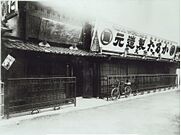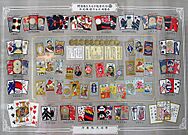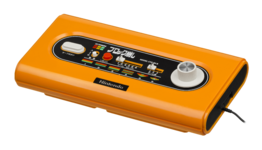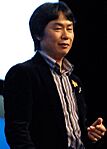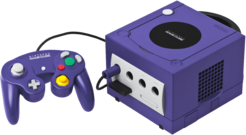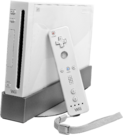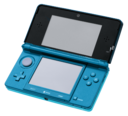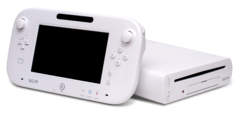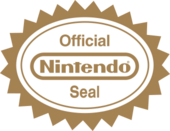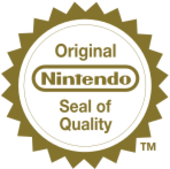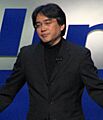Nintendo facts for kids
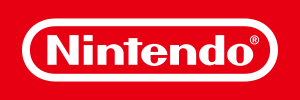
Logo since May 11, 2016
|
|
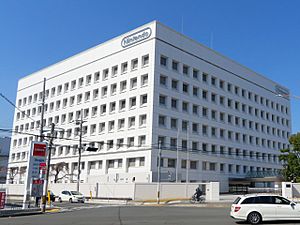
Headquarters in Kyoto, Japan
|
|
|
Native name
|
任天堂株式会社
|
|---|---|
|
Romanized name
|
Nintendō kabushiki gaisha |
|
Formerly
|
|
| Public | |
| Traded as |
|
| ISIN | ISIN: [https://isin.toolforge.org/?language=en&isin=JP3756600007 JP3756600007] |
| Industry |
|
| Founded | 23 September 1889 in Shimogyō-ku, Kyoto, Japan |
| Founder | Fusajiro Yamauchi |
| Headquarters | 11–1 Kamitoba Hokodatecho,
Minami-ku, Kyoto
,
Japan
|
|
Area served
|
Worldwide |
|
Key people
|
|
| Products | List of products |
| Brands |
Video game series
Animal Crossing
Art Style Big Brain Academy bit Generations BoxBoy! Brain Age Chibi-Robo! Cruis'n Custom Robo Donkey Kong Dr. Mario Excite F-Zero Famicom Detective Club Fire Emblem Fossil Fighters Golden Sun Kid Icarus Kirby The Legend of Zelda The Legendary Starfy Mario Mario Kart Mario Party Metroid Mother Pikmin Pilotwings Pokémon'' Punch-Out!! Puzzle League Rhythm Heaven Splatoon Star Fox Super Mario Super Smash Bros. Touch! Generations Wario Wars Wii Xenoblade Chronicles Yoshi |
|
Production output
|
|
| Services |
|
| Revenue | |
|
Operating income
|
|
| Total assets | |
| Total equity | |
|
Number of employees
|
8,205 (2025) |
| Divisions |
|
| Subsidiaries |
List
1-Up Studio
iQue Mario Club Monolith Soft Next Level Games Nintendo Cube Nintendo European Research & Development Nintendo Pictures Nintendo Sales Nintendo Software Technology Nintendo Systems (80%) Nintendo Technology Development Retro Studios Shiver Entertainment SRD |
Nintendo Co., Ltd. is a Japanese company famous for making video games and consoles. Based in Kyoto, Japan, Nintendo is known worldwide for creating some of the most popular games and characters in history.
The company started in 1889, when a craftsman named Fusajiro Yamauchi began making handmade hanafuda playing cards. For many years, Nintendo tried different businesses before it started making toys and video games in the 1960s and 1970s. The company became a huge success in the 1980s with the arcade game Donkey Kong and the Nintendo Entertainment System (NES), which launched with the classic game Super Mario Bros.
Since then, Nintendo has created many hit consoles. These include the Game Boy, the Super Nintendo Entertainment System (SNES), the Nintendo DS, the Wii, and the Nintendo Switch. The company has also created famous game series like Mario, The Legend of Zelda, Animal Crossing, and Pokémon.
Nintendo's mascot, Mario, is one of the most recognized characters in the world. Other characters like Luigi, Donkey Kong, Link, and Pikachu are also global stars. The company's worlds have even inspired movies and a theme park area called Super Nintendo World.
History
From Playing Cards to Toys
Nintendo was founded on September 23, 1889, by Fusajiro Yamauchi. At first, the company made and sold Japanese playing cards called hanafuda, which means "flower cards." These cards became very popular, and Yamauchi hired people to help make more of them. The business grew, and soon Nintendo was the biggest playing card company in Japan.
In 1929, Yamauchi's son-in-law, Sekiryo Kaneda, took over the company. In 1949, Sekiryo's grandson, Hiroshi Yamauchi, became president. Hiroshi made big changes. He started making the first plastic playing cards in Japan. In 1959, Nintendo partnered with Disney to put its characters on their cards. This was a huge success and helped Nintendo sell millions of packs.
By the 1960s, the playing card business was slowing down. Hiroshi Yamauchi knew Nintendo had to try something new. The company began making toys. One of the most famous was the Ultra Hand, an extending toy arm created by an employee named Gunpei Yokoi. It was a big hit, selling over a million units.
Entering the World of Video Games
In the 1970s, Nintendo saw the success of early video games from companies like Atari. Yamauchi decided to enter this new market. In 1977, Nintendo released the Color TV-Game, a home console that played simple games like tennis.
A young artist named Shigeru Miyamoto joined the company in 1977. He would go on to create some of Nintendo's most famous games. In 1980, Gunpei Yokoi designed the Game & Watch, a handheld device with a simple game and a clock. It was very popular and sold over 43 million units.
Nintendo's big break in arcades came in 1981 with Donkey Kong. The game, designed by Miyamoto, was about a hero named Jumpman who had to save a girl from a giant ape. Jumpman was later renamed Mario, and he became Nintendo's mascot. Donkey Kong was a massive success in Japan and America.
The NES and a New Era of Gaming
In 1983, the video game market in America crashed because there were too many low-quality games. Many people thought video games were just a fad. But Nintendo had a plan. In 1985, they released the Nintendo Entertainment System (NES) in North America.
The NES was a huge hit, thanks to amazing games like Super Mario Bros. and The Legend of Zelda. These games, created by Miyamoto and his team, set new standards for fun and adventure. The NES sold over 60 million consoles worldwide and made video games popular again.
In 1989, Nintendo launched the Game Boy, a handheld console that let people play games on the go. It came with the puzzle game Tetris, which made it incredibly popular. The Game Boy and its later version, the Game Boy Color, sold over 118 million units.
SNES, Nintendo 64, and 3D Gaming
In 1990, Nintendo released the Super Nintendo Entertainment System (SNES). It had better graphics and sound than the NES and featured classic games like Super Mario World and The Legend of Zelda: A Link to the Past. The SNES was a big success, selling nearly 50 million consoles.
The mid-1990s saw a big change in gaming: the move to 3D graphics. In 1996, Nintendo released the Nintendo 64. This console brought players into amazing 3D worlds for the first time. Games like Super Mario 64 and The Legend of Zelda: Ocarina of Time are still considered some of the best games ever made.
Also in 1996, the Pokémon series began on the Game Boy. Developed by Game Freak, Pokémon Red and Blue became a global phenomenon, starting a franchise of games, shows, and movies.
GameCube, Wii, and New Ways to Play
In 2001, Nintendo released two new systems: the GameCube for home gaming and the Game Boy Advance for handheld play. The GameCube had powerful graphics, but it faced tough competition. The Game Boy Advance was very successful, selling over 81 million units.
In 2002, Satoru Iwata became the new president of Nintendo. He wanted to create games that everyone could enjoy, not just hardcore gamers. This idea led to two of Nintendo's most successful systems.
The Nintendo DS, released in 2004, had two screens, including a touchscreen. It was a massive hit, selling over 154 million units, making it the second best-selling console of all time.
In 2006, Nintendo launched the Wii. Its motion-sensing Wii Remote controller was a revolutionary idea. It allowed players to swing a virtual tennis racket or baseball bat just by moving their arm. The Wii was incredibly popular with families and people of all ages, selling over 100 million consoles.
The Modern Era of Nintendo
In 2011, Nintendo released the Nintendo 3DS, a handheld that could display 3D graphics without special glasses. It was a strong seller, with over 75 million units sold. However, its home console, the Wii U (2012), was less successful.
Following the death of Satoru Iwata in 2015, Nintendo began to explore new areas, including mobile games like Super Mario Run and Pokémon Go. The company also partnered with Universal Parks & Resorts to create Super Nintendo World theme park areas.
In 2017, Nintendo released the Nintendo Switch. This unique system works as both a home console connected to a TV and a portable handheld device. The Switch was an instant success, thanks to amazing games like The Legend of Zelda: Breath of the Wild and Super Mario Odyssey. It has sold over 150 million units, becoming Nintendo's best-selling home console ever.
In 2025, Nintendo launched the Nintendo Switch 2. It featured a larger screen, better graphics, and more power. The console sold over 3.5 million units in its first few days, making it the fastest-selling console in history.
Famous Nintendo Games and Consoles
Nintendo is known for creating both innovative hardware and unforgettable software.
Video Game Consoles
Since 1977, Nintendo has made home consoles, handhelds, and hybrid systems. Some of the most famous include:
- Nintendo Entertainment System (NES): The console that saved the video game industry in the 1980s.
- Game Boy: The handheld that made gaming portable.
- Super Nintendo Entertainment System (SNES): A 16-bit powerhouse with many classic games.
- Nintendo 64: Led the way into 3D gaming.
- Nintendo DS: A dual-screen handheld that became a massive success.
- Wii: Introduced motion controls to millions of players.
- Nintendo Switch: A hybrid console that can be played anywhere.
Video Games
Nintendo has created many of the world's most beloved game franchises. Some of the biggest include:
- Super Mario: A series of platforming games starring Mario, one of the most famous characters in the world.
- The Legend of Zelda: Epic adventure games where players control the hero, Link.
- Pokémon: A series about catching, training, and battling creatures called Pokémon.
- Mario Kart: Fun racing games featuring characters from the Mario universe.
- Animal Crossing: A relaxing game where players live in a town with animal neighbors.
- Super Smash Bros.: A fighting game where famous characters from Nintendo and other companies battle.
Company and Culture
Nintendo's main goal is to create fun and surprising entertainment for everyone. The company has offices all over the world, but its main headquarters has always been in Kyoto, Japan.
Development Teams
Nintendo has several teams that create its games and consoles.
- Nintendo Entertainment Planning & Development (EPD): This is the main team that makes most of Nintendo's biggest games, like Mario and Zelda.
- Nintendo Platform Technology Development (PTD): This team designs the hardware, like the Nintendo Switch console and its Joy-Con controllers.
Nintendo also owns other game studios, such as Retro Studios (who made the Metroid Prime series) and Monolith Soft (creators of the Xenoblade Chronicles series).
Seal of Quality
For many years, Nintendo has put a "Seal of Quality" on its products. This seal lets customers know that the game or accessory is an official product and has been approved by Nintendo. It was a way to promise players that they were buying a quality product. This helped build trust with customers, especially after the video game market crash of 1983.
Images for kids
-
The Virtual Boy was an early attempt at 3D gaming released in 1995.
-
The Game Boy Color, released in 1998, added a color screen to the classic handheld.
-
The Game Boy Advance from 2001 had a wider screen and more power.
-
Satoru Iwata was Nintendo's president from 2002 to 2015.
-
Reggie Fils-Aimé was the popular president of Nintendo of America from 2006 to 2019.
-
Pokémon Go is a popular mobile game that uses your phone's GPS.
-
The Nintendo Switch in TV mode, with the main unit in its dock.
-
The Nintendo Switch in handheld mode, with the Joy-Con controllers attached.
-
The Nintendo Switch 2 in TV mode.
-
The Nintendo Switch 2 in handheld mode.
See also
 In Spanish: Nintendo para niños
In Spanish: Nintendo para niños
- Lewis Galoob Toys, Inc. v. Nintendo of America, Inc.
- Universal City Studios, Inc. v. Nintendo Co., Ltd.


